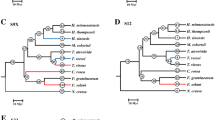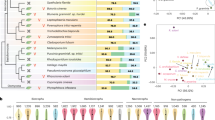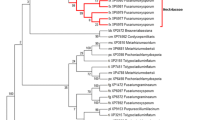Abstract
The Pr1 family of serine endopeptidases plays an important role in pathogenicity and virulence of entomopathogens such as Metarhizium anisopliae (Ascomycota: Hypocreales). These virulence factors allow for the penetration of the host cuticle, a vital step in the infective process of this fungus, which possesses 11 Pr1 isoforms (Pr1A through Pr1K). The family is divided into two classes with Class II (proteinase K-like) comprising 10 isoforms further split into three subfamilies. It is believed that these isoforms act synergistically and with other virulence factors, allowing pathogenicity to multiple hosts. As virulence coevolves through reciprocal selection with hosts, positive selection may lead to the evolution of new protease families or isoforms of extant ones that can withstand host defenses. This work tests this hypothesis in Class II Pr1 proteins, focusing on M. anisopliae, employing different methods for phylogenetic inference in amino acid and nucleotide datasets in multiple arrangements for Metarhizium spp. and related species. Phylogenies depict groups that match the taxonomy of their respective organisms with high statistical support, with minor discrepancies. Positively selected sites were identified in six out of ten Pr1 isoforms, most of them located in the proteolytic domain and spatially close to the catalytic residues. Moreover, there was evidence of functional divergence in the majority of pairwise comparisons. These results imply the existence of differential selective pressure acting on Pr1 proteins and a potential new isoform, likely affecting host specificities, virulence, or even adapting the organism to different host-independent lifestyles.






Similar content being viewed by others
References
Abascal F, Zardoya R, Posada D (2005) ProtTest: selection of best-fit models of protein evolution. Bioinformatics 21:2104–2105
Abascal F, Zardoya R, Telford MJ (2010) TranslatorX: multiple alignment of nucleotide sequences guided by amino acid translations. Nucleic Acids Res 38:W7–W13
Altekar G, Dwarkadas S, Huelsenbeck JP, Ronquist F (2004) Parallel Metropolis coupled Markov chain Monte Carlo for Bayesian phylogenetic inference. Bioinformatics 20:407–415
Anisimova M, Bielawski JP, Yang Z (2002) Accuracy and power of Bayes prediction of amino acid sites under positive selection. Mol Biol Evol 19:950–958
Ayres DL, Darling A, Zwickl DJ, Beerli P, Holder MT, Lewis PO, Huelsenbeck JP, Ronquist F, Swofford DL, Cummings MP, Rambaut A, Suchard MA (2012) BEAGLE: an application programming interface and high-performance computing library for statistical phylogenetics. Syst Biol 61:170–173
Bagga S, Hu G, Screen SE, St. Leger RJ (2004) Reconstructing the diversification of subtilisins in the pathogenic fungus Metarhizium anisopliae. Gene 324:159–169
Barelli L, Moonjely S, Behie SW, Bidochka MJ (2016) Fungi with multifunctional lifestyles: endophytic insect pathogenic fungi. Plant Mol Biol 90:657–664
Berman H, Henrick K, Nakamura H (2003) Announcing the worldwide Protein Data Bank. Nat Struct Mol Biol 10:980–980
Berman H, Henrick K, Nakamura H, Markley JL (2007) The worldwide Protein Data Bank (wwPDB): ensuring a single, uniform archive of PDB data. Nucleic Acids Res 35:D301–D303
Betzel C, Pal GP, Saenger W (1988) Three-dimensional structure of proteinase K at 0.15-nm resolution. Eur J Biochem 178:155–171
Betzel C, Gourinath S, Kumar P, Kaur P, Perbandt M, Eschenburg S, Singh TP (2001) Structure of a serine protease proteinase K from Tritirachium album limber at 0.98 Å resolution. Biochemistry 40:3080–3088
Beys-da-Silva WO, Santi L, Berger M, Calzolari D, Passos DO, Guimarães JA, Moresco JJ, Yates JR (2014) Secretome of the biocontrol agent Metarhizium anisopliae induced by the cuticle of the cotton pest Dysdercus peruvianus Reveals new insights into infection. J Proteome Res 13:2282–2296
Butt TM, Coates CJ, Dubovskiy IM, Ratcliffe NA (2016) Entomopathogenic fungi: new insights into host–pathogen interactions. In: Advances in genetics, vol 94. Elsevier, Amsterdam, p 307–364
Camacho C, Coulouris G, Avagyan V, Ma N, Papadopoulos J, Bealer K, Madden TL (2009) BLAST+: architecture and applications. BMC Bioinformatics 10:421
Darriba D, Taboada GL, Doallo R, Posada D (2011) ProtTest 3: fast selection of best-fit models of protein evolution. Bioinformatics 27:1164–1165
Darriba D, Taboada GL, Doallo R, Posada D (2012) jModelTest 2: more models, new heuristics and parallel computing. Nat Methods 9:772–772
Eddy SR (1998) Profile hidden Markov models. Bioinformatics 14:755–763
Faria MR de, Wraight SP (2007) Mycoinsecticides and mycoacaricides: a comprehensive list with worldwide coverage and international classification of formulation types. Biol Control 43:237–256
Finn RD, Clements J, Eddy SR (2011) HMMER web server: interactive sequence similarity searching. Nucleic Acids Res 39:W29–W37
Finn RD, Bateman A, Clements J, Coggil P, Eberhardt RY, Eddy SR, Heger A, Hetherington K, Holm L, Mistry J, Sonnhammer ELL, Tate J, Punta M (2014) Pfam: the protein families database. Nucleic Acids Res 42:D222–D230
Freimoser FM, Screen S, Bagga S, Hu G, St. Leger RJ (2003) Expressed sequence tag (EST) analysis of two subspecies of Metarhizium anisopliae reveals a plethora of secreted proteins with potential activity in insect hosts. Microbiology 149:239–247
Freimoser FM, Hu G, St. Leger RJ (2005) Variation in gene expression patterns as the insect pathogen Metarhizium anisopliae adapts to different host cuticles or nutrient deprivation in vitro. Microbiology 151:361–371
Gascuel O (1997) BIONJ: an improved version of the NJ algorithm based on a simple model of sequence data. Mol Biol Evol 14:685–695
Gouy M, Guindon S, Gascuel O (2010) SeaView version 4: a multiplatform graphical user interface for sequence alignment and phylogenetic tree building. Mol Biol Evol 27:221–224
Greenfield BPJ, Peace A, Evans H, Dudley E, Ansari MA, Butt TM (2015) Identification of Metarhizium strains highly efficacious against Aedes, Anopheles and Culex larvae. Biocontrol Sci Technol 25:487–502
Gu X (1999) Statistical methods for testing functional divergence after gene duplication. Mol Biol Evol 16:1664–1674
Gu X (2001) Maximum-likelihood approach for gene family evolution under functional divergence. Mol Biol Evol 18:453–464
Gu X (2003) Functional divergence in protein (family) sequence evolution. In: Long M (ed) Origin and evolution of new gene functions. Contemporary issues in genetics and evolution, vol 10. Springer, Dordrecht
Gu X, Wang Y, Gu J, Velden KV, Xu D (2006) Predicting type-I (rate-shift) functional divergence of protein sequences and applications in functional genomics. Curr Genomics 7:87–96
Gu X, Zou Y, Su Z, Huang W, Zhou Z, Arendsee Z, Zeng Y (2013) An update of DIVERGE software for functional divergence analysis of protein family. Mol Biol Evol 30:1713–1719
Guindon S, Gascuel O (2003) A simple, fast, and accurate algorithm to estimate large phylogenies by maximum likelihood. Syst Biol 52:696–704
Hasegawa M, Kishino H, Yano T (1985) Dating of the human-ape splitting by a molecular clock of mitochondrial DNA. J Mol Evol 22:160–174
Holder M, Lewis PO (2003) Phylogeny estimation: traditional and Bayesian approaches. Nat Rev Genet 4:275–284
Hu G, St. Leger RJ (2004) A phylogenomic approach to reconstructing the diversification of serine proteases in fungi. J Evol Biol 17:1204–1214
Hu X, Xiao G, Zheng P, Shang Y, Su Y, Zhang X, Liu X, Zhan S, St. Leger RJ, Wang C (2014) Trajectory and genomic determinants of fungal-pathogen speciation and host adaptation. Proc Natl Acad Sci USA 111:1–6
Javar S, Mohamed R, Sajap AS, Lau W-H (2015) Expression of pathogenesis-related genes in Metarhizium anisopliae when infecting Spodoptera exigua. Biol Control 85:30–36
Jones DT, Taylor WR, Thornton JM (1992) The rapid generation of mutation data matrices from protein sequences. Bioinformatics 8:275–282
Khan FI, Wei D-Q, Gu K-R, Hassan MI, Tabrez S (2016) Current updates on computer aided protein modeling and designing. Int J Biol Macromol 85:48–62
Landan G, Graur D (2008) Local reliability measures from sets of co-optimal multiple sequence alignments. Pac Symp Biocomput 15–24
Larsson A (2014) AliView: a fast and lightweight alignment viewer and editor for large datasets. Bioinformatics 30:3276–3278
Le SQ, Gascuel O (2008) An Improved general amino acid replacement matrix. Mol Biol Evol 25:1307–1320
Li J, Yu L, Yang J, Dong L, Tian B, Yu Z, Liang L, Zhang Y, Wang X, Zhang K (2010) New insights into the evolution of subtilisin-like serine protease genes in Pezizomycotina. BMC Evol Biol 10:68
Li J, Gu F, Wu R, Yang J, Zhang K-Q (2017) Phylogenomic evolutionary surveys of subtilase superfamily genes in fungi. Sci Rep 7:45456
Löytynoja A (2014) Phylogeny-aware alignment with PRANK. In: Russell DJ (ed) Multiple sequence alignment methods. Humana Press, New Yprk, p 155–170
Martoglio B, Dobberstein B, Carafoli E (1998) Signal sequences: more than just greasy peptides. Trends Cell Biol 8:410–415
Nye T (2008) Trees of trees: an approach to comparing multiple alternative phylogenies. Syst Biol 57:785–794
Pearson WR (2013) An Introduction to sequence similarity (“homology”) searching. Curr Protoc Bioinforma 42:3.1.1–3.1.8
Pei J, Kim B-H, Grishin NV (2008) PROMALS3D: a tool for multiple protein sequence and structure alignments. Nucleic Acids Res 36:2295–2300
Rambaut A (2016) FigTree. http://tree.bio.ed.ac.uk/software/figtree/. Accessed 15 Mar 2015
Ronquist F, Teslenko M, van der Mark P, Ayres DL, Darling A, Höhna S, Larget B, Liu L, Suchard MA, Huelsenbeck JP (2012) MrBayes 3.2: efficient Bayesian phylogenetic inference and model choice across a large model space. Syst Biol 61:539–542
Rosas-García NM, Avalos-de-León O, Villegas-Mendoza JM, Mireles-Martínez M, Barboza-Corona JE, Castañeda-Ramírez JC (2014) Correlation between Pr1 and Pr2 gene content and virulence in Metarhizium anisopliae strains. J Microbiol Biotechnol 24:1495–1502
Sánchez-Pérez L, de C, Barranco-Florido, Rodríguez-Navarro JE, Cervantes-Mayagoitia S, Ramos-López JF MÁ (2014) Enzymes of entomopathogenic fungi, advances and insights. Adv Enzym Res 02:65–76
Santi L, Silva WOB, Pinto AFM, Schrank A, Vainstein MH (2010) Metarhizium anisopliae host-pathogen interaction: differential immunoproteomics reveals proteins involved in the infection process of arthropods. Fungal Biol 114:312–319
Schrank A, Vainstein MH (2010) Metarhizium anisopliae enzymes and toxins. Toxicon 56:1267–1274
Schrödinger L (2015) The PyMOL Molecular Graphics System, Version 2.2
Sela I, Ashkenazy H, Katoh K, Pupko T (2015) GUIDANCE2: accurate detection of unreliable alignment regions accounting for the uncertainty of multiple parameters. Nucleic Acids Res 43:W7–W14
Small C-LN, Bidochka MJ (2005) Up-regulation of Pr1, a subtilisin-like protease, during conidiation in the insect pathogen Metarhizium anisopliae. Mycol Res 109:307–313
St Leger RJ (2008) Studies on adaptations of Metarhizium anisopliae to life in the soil. J Invertebr Pathol 98:271–276
St Leger RJ, Bidochka MJ, Roberts DW (1994) Isoforms of the cuticle-degrading Pr1 proteinase and production of a metalloproteinase by Metarhizium anisopliae. Arch Biochem Biophys 313:1–7
Staats CC, Junges A, Guedes RLM, Thompson CE, Morais GL, Boldo JT, Almeida LGP, Andreis FC, Gerber AL, Sbaraini N, Paixão RLA, Broetto L, Landell M, Santi L, Beys-da-Silva WO, Silveira CP, Serrano TR, Oliveira ES, Kmetzsch L, Vainstein MH, Vasconcelos ATR, Schrank A (2014) Comparative genome analysis of entomopathogenic fungi reveals a complex set of secreted proteins. BMC Genom 15:822
Stöver BC, Müller KF (2010) TreeGraph 2: combining and visualizing evidence from different phylogenetic analyses. BMC Bioinformatics 11:7
Tavaré S (1986) Some probabilistic and statistical problems in the analysis of DNA sequences. Am Math Soc Lect Math Life Sci 17:57–86
Varshney D, Jaiswar A, Adholeya A, Prasad P (2016) Phylogenetic analyses reveal molecular signatures associated with functional divergence among Subtilisin like Serine Proteases are linked to lifestyle transitions in Hypocreales. BMC Evol Biol 16:220
Vilcinskas A (2010) Coevolution between pathogen-derived proteinases and proteinase inhibitors of host insects. Virulence 1:206–214
Whelan S, Goldman N (2001) A general empirical model of protein evolution derived from multiple protein families using a maximum-likelihood approach. Mol Biol Evol 18:691–699
Yang Z (2007) PAML 4: phylogenetic analysis by maximum likelihood. Mol Biol Evol 24:1586–1591
Zimmermann G, Papierok B, Glare T (1995) Elias Metschnikoff, Elie Metchnikoff or ilya ilich mechnikov (1845–1916): a pioneer in insect pathology, the first describer of the entomopathogenic fungus Metarhizium anisopliae and how to translate a Russian Name. Biocontrol Sci Technol 5:527–530
Acknowledgements
The authors would like to thank BV, CLF, CLM, JFRB, GPP, MT, RKC, RLB, and NSO for insightful discussions, suggestions and overall support. This work was supported by the following Brazilian agencies: Coordenação de Aperfeiçoamento de Pessoal de Nível Superior (CAPES) [Grant: Biocomputacional 23038.010041/2013-13, Rede Avançada em Biologia Computacional (RABICÓ)], Conselho Nacional de Desenvolvimento Científico e Tecnológico (CNPq) [Grant: Universal 2014 458160/2014-8].
Author information
Authors and Affiliations
Corresponding author
Ethics declarations
Conflict of interest
The authors declare that they have no conflict of interest.
Ethical approval
This article does not contain any studies with human participants or animals performed by any of the authors.
Additional information
Communicated by Stefan Hohmann.
Publisher’s Note
Springer Nature remains neutral with regard to jurisdictional claims in published maps and institutional affiliations.
Electronic supplementary material
Below is the link to the electronic supplementary material.
438_2019_1546_MOESM1_ESM.pdf
Online Resource 1: Employed sequence alignments with highlighted positively selected and filtered sites, when applicable
Rights and permissions
About this article
Cite this article
Andreis, F.C., Schrank, A. & Thompson, C.E. Molecular evolution of Pr1 proteases depicts ongoing diversification in Metarhizium spp. Mol Genet Genomics 294, 901–917 (2019). https://doi.org/10.1007/s00438-019-01546-y
Received:
Accepted:
Published:
Issue Date:
DOI: https://doi.org/10.1007/s00438-019-01546-y




